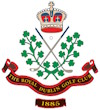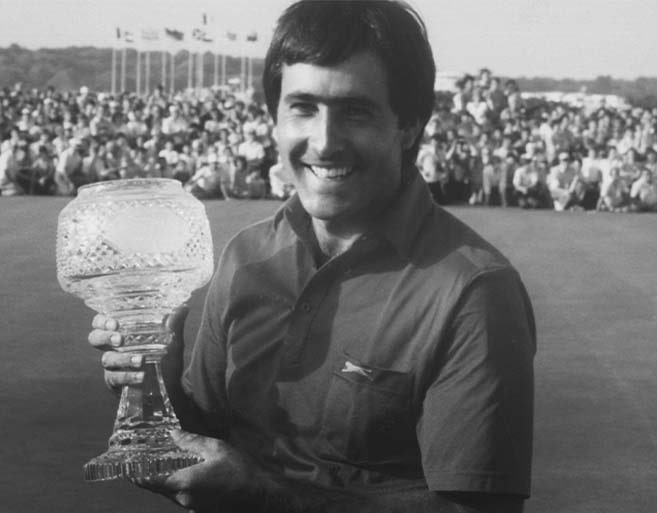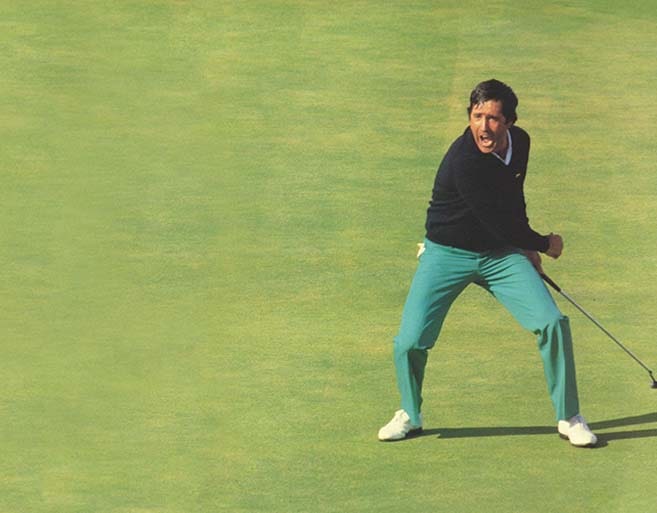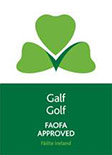Christy O'Connor
Christy O’Connor was a 25-year-old assistant professional at Galway GC, when he decided on a trip to the capital so as to broaden his golfing education. With an elite field of 96 competitors assembled at Royal Dublin for the 1950 Irish Open Championship, his objective, as he put it, was “to see top professionals such as Dai Rees and Australia’s Norman von Nida in action.”
As it happened, a lesser-known Australian, Ossie Pickworth, captured the title. On his journey back to the west, however, the young Galwayman’s thoughts were dominated by images not of distinguished players, but of a celebrated links which had captured his heart. “I loved Royal Dublin from first sight, and I remember thinking that I couldn’t wait to get back there,” he later remarked. This was the traditional, out-and-back layout which the great English architect, Harry Colt, had crafted on Dollymount’s Bull Island, after it was returned to the members having served as a musketry range during World War I. And through remarkable developments for both player and club, it would become Christy’s golfing home from April 1959 until his death in May 2016 at the grand old age of 91.
When Royal Dublin advertised for a professional early in 1959, Christy chose not to apply for the job. Remarkably, he didn’t consider himself worthy of attachment to such a distinguished club, despite being by then, an established winner on the embryonic European Tour along with two appearances in the Ryder Cup and a victory the previous November as Harry Bradshaw’s partner in the Canada Cup in Mexico City. So, determined to get their man, the club felt obliged to send a deputation down to Killarney GC, where Christy was then attached. "I remember when I wasn't showing that much interest, Mary [Christy’s wife] kicked me under the table," he later recalled. "She was fed up with all the driving to Shannon Airport when I'd be coming back from trips abroad.”

So the deal was done and a remarkable association of employer and employee, began to take shape. The admiration sparked by Christy’s 1950 visit developed into a profound love of the place. Then there were the club members. "They’ve been fantastic to me," he later remarked. "From the very start, I was invited to captains' dinners, which didn't often happen to club pros at that time. Then they made me a honorary life member." Christy and Royal Dublin became very good for each other, with the player happy to fulfil his role in enhancing the club’s image, either through his tournament exploits abroad or his physical presence on site. As each triumph was reported, newspaper phrases such as “Christy O’Connor, the Royal Dublin maestro” were to became a familiar part of golfing lore.
Indeed on a rather special weekend in 1966, the club was to experience the best of both worlds. That was when the scoring sequence of eagle, birdie, eagle would link Christy and Royal Dublin indelibly to the climax of the Carrolls International. It was a time when Himself, as he became affectionately known, was at the peak of his formidable powers, though he faced Sunday’s climax a stroke behind the leader, Eric Brown, after rounds of 71,68 and 67.
In the event, a closing 69 for an aggregate of 274, seemed to assure Brown of victory. Yet for all his vast experience of the professional arena, the Scot couldn’t have imagined what was about to unfold. Standing on the 16th tee on 11 under par, three strokes short of Brown’s clubhouse target, Christy commenced an electrifying, finishing surge. Having driven the green to be 16 feet above the hole, he rolled in the putt for an eagle-two. A huge drive then found the middle of the 17th fairway from where an over-zealous approach send the ball 20 feet past the pin. But the putt still found the target. With a birdie-three, he was level with Brown.
By this stage, huge crowds were scurrying on either side of the finishing hole, which their hero played to perfection. Splitting the fairway with a three-wood off the tee, his three-iron second shot over the Garden was so precise that the ball narrowly missed the pin before coming to rest nine feet away. Though two putts would have given him victory, he took only one, to resounding cheers from the delighted faithful.
Two decades later, appearances in the Irish Open at Royal Dublin would draw glowing comments from such golfing luminaries as Lee Trevino, who remarked: “Christy’s swing still flows like fine wine.” And further tournament exploits on home terrain would include a record-equalling 10th Irish Professional Championship triumph in 1978 and a tie with Tommy Horton in the 1992 PGA Seniors, before losing in a play-off.
Then there was his influence on newcomers to the ranks. Looking to a career as a tournament professional, Padraig Harrington considered it appropriate to head to Royal Dublin on a bleak January day in the hope of seeing Christy hit practice balls. His face stinging from sharp winds, he came across a familiar, lone figure, considerably older than in the picture he kept on his bedroom wall as a youngster.
“Most people wouldn't have let their dog out," recalled the winner of three Major championships. “Yet Christy was there in the Garden hitting shots. I figured at the time that nobody in the world could have played one particular shot, a six-iron of maybe 140 yards which he was holding onto the wind with a low draw. Then he hit a few fades. It was just spectacular. Here was a man in his late sixties at the time, who still had the will to go out in that weather and hit those wonderful shots." It was May in 2009 when Christy was formally told of his elevation into the World Golf Hall of Fame. And the occasion was marked by a phone call from Jack Nicklaus. "The timing was pretty good because I caught him on the first tee at Royal Dublin and Christy Junior was there, too,” recalled the Bear, who described the distinction as “A great honour and well deserved.”
As autumn years eased into the winter of a long, fruitful career, Royal Dublin remained dear to Christy’s heart. Attendance at each New Year captain’s drive-in remained a top priority. And in quieter moments, he could be observed in his familiar Audi car, driving down the service road beside the back-nine to watch his beloved members in action.
Sometimes the car would stop and out would step this legendary figure with a mid-iron in one hand and golf-balls in the other. And he would attempt, with an easy half-swing, to recapture the feel of his glory years by hitting a few, gentle shots.
This was Christy O’Connor. Royal Dublin will never see his like again.






